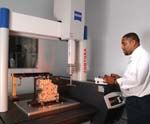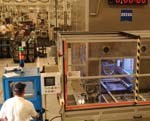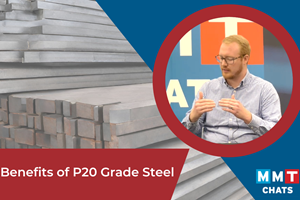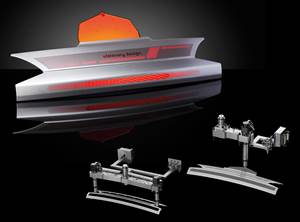Automotive OEM Employs Shopfloor CMMs To Improve Process Control
GM expects first-time quality from transmissions manufactured at this major manufacturer, which are shipped directly to the GM assembly line. There are no incoming quality checks or receiving inspection routines.
An expansion order from General Motors' Michigan powertrain facility prompted Allison Transmission (Indianapolis, Indiana), an automotive OEM, to build a new facility in Baltimore, Maryland, to produce transmissions for the 2500 and 3500 Chevrolet Silverado and GMC Sierra pickup truck series. The facility operates on a lean manufacturing concept.
GM expects first-time quality from transmissions manufactured at Allison, which are shipped directly to the GM assembly line. There are no incoming quality checks or receiving inspection routines.
John Russell, quality engineer at Allison, spent the first six months of operation trying to get his department's touch-trigger coordinate measuring machine (CMM) to work properly before deciding to purchase a new one.
"We needed a CMM that could run 20 hours a day, 6 days a week without fail," Mr. Russell says. "The system needed to meet our 0.0005-inch accuracy requirements and help improve our manufacturing process."
Allison had already installed a Contura scanning CMM from Carl Zeiss IMT Corporation (Minneapolis, Minnesota) to conduct measurements on the transmission valve body machined in another part of its facility. After inquiring with Zeiss, Allison installed a Zeiss Prismo scanning CMM. Both systems now aid the manufacturing of two parts that make up the transmission shell—the valve body and the main case.
The Prismo measures approximately 270 features on the main case, taking only 46 minutes per part. Part inspection throughput has increased 20 percent since installing the CMM. Set up on the shop floor in an enclosed, turnkey workstation, the machine is connected to a two-station automated pallet changer and automatically runs a sequence of measurements. After the system is programmed, an operator simply presses a few buttons to initiate a measurement run.
"The CMM enclosure is equipped with an LED display on the front that clearly shows how much time is left until the end of a measurement cycle," Mr. Russell says. "With the automated programmable measurement cycles and pallet changer, inspection routines are constant, and our operators are free to perform other tasks."
Because of fluctuating room and part temperatures, sensors are attached to the part surface to acquire real-time temperature data. This is factored into the results to ensure measurement accuracy.
The Prismo software, UMESS, supports true geometric tolerancing, measuring true position (size and hole position) to within 0.0002 inch. UMESS is used to conduct complex measurement tasks, including coaxiality and concentricity, and networking with other CAD systems.
"Our operators can download CAD files to the CMM to develop automated inspection programs," Mr. Russell says. "If we have a part without a design drawing, UMESS has reverse engineering capabilities to digitize dimensions directly from a part profile and create a CAD file."
Allison also integrated the Zeiss Strata SPC analysis software into the Prismo CMM to graphically illustrate measurement results and determine machining trends. Without trend analysis, operators must determine whether they should react to a flyer—a bad data point caused by a machining burr—that shows an out-of-tolerance condition.
Approximately 88 threaded holes are measured between the main case and the valve body. Before the Prismo, the threaded hole couldn't be directly measured. Inspection operators had to insert a precision-ground gage pin into a threaded hole, measure the pin and interpret those results to determine the hole measurements.
"The scanning CMMs have the ability to probe threaded holes and provide point density," Mr. Russell says. "As the probe scans inner threads, it collects thousands of points. Data output is based on 3,000 points versus six or eight, and consistent measurement results have increased confidence in our manufacturing capabilities."
The Zeiss Contura has generated significant time and cost savings for Allison by eliminating manual inspection processes using hand tools and removing the need for calibration, maintenance and backup replacement gages.
"If my measurement processes are generating out-of-tolerance results, I have to determine whether it's the measurement tools or the machine tools working improperly," says Bruce Barnett, manufacturing engineer. "The Contura's repeatable results tell me what I need to know."
Allison has gone from using CMMs for part inspection to a means of improving its overall manufacturing process. Technicians have gained more confidence in the results because they are now given enough data to understand why a process might be going wrong and what the causes might be.
"Most CMMs measure a part, generate a report, and if something is out of tolerance, an operator has to react, but you have already made a nonconforming part," Mr. Russell says. "Measurement results on the Prismo and Contura not only indicate whether a part is good or bad, but they also give us much more information for understanding what's happening with our processes and when it's time to react. They give us process control."
Related Content
Project Reveals Added Benefits of New P20 Grade Steel in Machinability, Cycle Time and No Stress Relief
MoldMaking Technology's Christina Fuges talks with General Motors' Shane Appel about a project testing a new P20 steel grade's dimensional stability.
Read MoreHot Runner Technologies Advance Quality Surface Requirements in Automotive
Oerlikon HRSflow hot runner systems combine cost-efficient production with a precise process control for a variety of automotive applications.
Read MoreMold Builder Uses Counter-Intuitive Approach for Mold Challenges
Matrix Tool Inc. answers customers’ hard questions with creative solutions for cavity spacing, tool sizing, runner layout and melt delivery that reveal the benefits of running in a smaller press size at lower cavitation but higher yield.
Read MoreAxiom Group United Under New Corporate Structure and Branding
Global injection and molding industry contender Axiom Group unites its core brand under a “One Axiom” approach and introduces a new brand design to position itself at the forefront of automotive innovation.
Read MoreRead Next
How to Use Strategic Planning Tools, Data to Manage the Human Side of Business
Q&A with Marion Wells, MMT EAB member and founder of Human Asset Management.
Read MoreHow to Use Continuing Education to Remain Competitive in Moldmaking
Continued training helps moldmakers make tooling decisions and properly use the latest cutting tool to efficiently machine high-quality molds.
Read MoreReasons to Use Fiber Lasers for Mold Cleaning
Fiber lasers offer a simplicity, speed, control and portability, minimizing mold cleaning risks.
Read More













.jpg;maxWidth=300;quality=90)



_300x250 1.png;maxWidth=300;quality=90)









_970x250 4.png;maxWidth=970;quality=90)